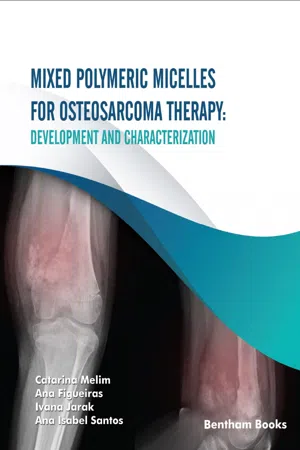
Mixed Polymeric Micelles for Osteosarcoma Therapy
Development and Characterization
- English
- ePUB (mobile friendly)
- Available on iOS & Android
Mixed Polymeric Micelles for Osteosarcoma Therapy
Development and Characterization
About This Book
Osteosarcoma is a rare bone tumor that has a high incidence amongchildren and young adults. Despite recent therapeutic developments, osteosarcomastill presents major hurdles to achieving successful results, mainly due to thepresence of multi-drug-resistant cells.This monograph primarily aims to provide information about the basicscience behind the treatment of osteosarcoma along with experimental resultsfor a novel formulation that overcomes multidrug resistance, and therefore, mayserve as a viable treatment option. The book starts with an updated and conciseguide to the pathophysiology of the disease, while also introducing the readerto new therapies and materials (specifically chitosan, polyethyleneimine, poloxamers, poloxamines, and Pluronics®) used in the treatment process along with the aimsof the experiments present subsequently. Next, the book documents the materialsand methods used in developing polymeric micelles for delivering drugs toosteosarcoma sites. By explaining the basics of nanomedicine as a startingpoint, readers will understand how polymeric micelles act as facilitators ofdrug transport to cancer cells, and how one can synthesize a small stablemicelle (by creating derivatives of base nanomaterials), capable of activelytargeting osteosarcoma cells and overcoming multi-drug resistance. The chapterexplains the synthesis and characterization techniques of the materials used todevelop polymeric micelles.The results, a reflection of the conjugation of different experimentalsolutions initiated here, point to a modern route towards the search for a therapeutic solution for osteosarcoma.The simple, structured presentation coupled with relevant informationon the subject of micelle-based nanotherapeutic drug delivery make thismonograph an essential handbook for pharmaceutical scientists involved in thefield of nanomedicine, drug delivery, cancer therapy and any researchersassisting specialists in clinical oncology for the treatment of osteosarcoma.
Frequently asked questions
Information
Introduction
1. Osteosarcoma
| Osteosarcoma Subtype | Histological Characteristics |
|---|---|
| Low-grade central | Fibroblastic stroma of variable cellularity; osteoids arranged in parallel seams resembling parosteal osteosarcoma |
| Conventional | Subdivided into osteoblastic, fibroblastic, and chondroblastic subtypes; bone or osteoid production by tumor cells |
| Telangiectatic | Dilated blood-filled cavities; high-grade sarcomatous cells on the septae and peripheral rim |
| Small-cell | Small-cell production; round hypochromatic nuclei with slight nuclear polymorphism |
| Parosteal | Fibroblastic in appearance; streams of bone trabeculae arranged in a parallel orientation |
| Periosteal | Chondroblastic in appearance; matrix component mainly cartilaginous |
| High-grade surface | Malignant spindle cells; high degree of atypical cells |
1.1. Pathophysiology
Table of contents
- Welcome
- Table of Content
- Title
- BENTHAM SCIENCE PUBLISHERS LTD.
- FOREWORD
- PREFACE
- Abstract
- Introduction
- Materials and Methods
- Results and Discussion
- Conclusion
- Annex
- ABBREVIATIONS
- REFERENCES